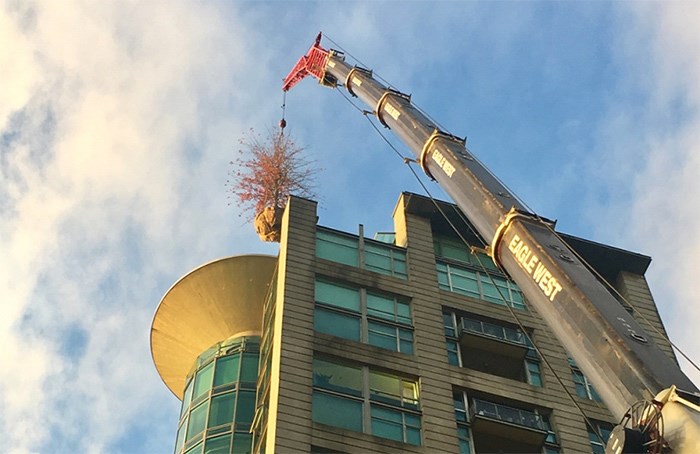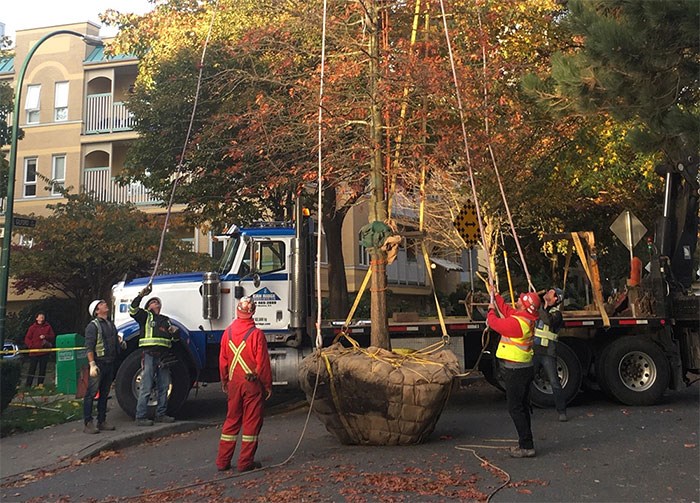 The two-year-old pin oak is lifted 60 metres up to the roof deck of Eugenia Place. Photograph By Jess Ketchum
The two-year-old pin oak is lifted 60 metres up to the roof deck of Eugenia Place. Photograph By Jess Ketchum
The rumours that Leonard Nimoy once lived at Eugenia Place will forever be a part of Â鶹´«Ă˝Ół»folklore.
The claim that the Star Trek actor once occupied the penthouse of the distinctive West End tower with the oak tree on top has been swirling for years.
On Wednesday, work crews were probably wishing for some U.S.S. Enterprise technology to help beam up a replacement tree to the roof level of the 19-floor high-rise.
Eugenia Place, located at 1919 Beach Ave., had sported an 11-metre-tall tree on its roof – around 60 metres above the ground – since the building’s completion in 1987. Until May, that is, when it was removed due to poor health.
Many West End residents lamented the removal of what had become a neighbourhood landmark and an often-photographed attraction for tourists walking or biking the nearby seawall by English Bay.
Eugenia Place won a Governor General’s Award for Architecture for Henriquez Partners Architects after its completion, in part for its pin oak installation, which was designed to illustrate the height of the red cedars and Douglas firs that populated the area before the city was built.
 Crews prepare the pin oak for flight. – Jess Ketchum
Crews prepare the pin oak for flight. – Jess Ketchum
The pin oak species was chosen because of its particular properties, including tolerance to urban pollution and its weight distribution.
“Wind is a big factor when something’s up that high, so we want the branching to be as light as possible. Most of the weight is in the lower trunk,” said landscape architect Ron Rule, who reprised his role from 1987 in coordinating the tree lift.
At the time of the original tree's removal, the work to replace it was estimated to cost more than $500,000.
The new tree for the rooftop was selected two years ago and carefully nurtured in the Fraser Valley before being brought to the city this week. On Wednesday, crowds gathered to watch a 270-tonne crane lift the Eugenia’s newest occupant into the specially designed bowl-shaped bed on the roof deck – not before 18 tons of fresh soil were transported in the same way.
“Everything is a challenge with this,” said Rule about the operation to replace the tree. “When you have a tree that’s going up 19 storeys on an existing building in a heavily populated neighbourhood, the No. 1 concern is safety, and No. 2 is for the health of the tree.”
It’s currently around 10.5 metres tall but won’t grow much taller due to its limited environment. It’ll be lashed in place with metal hooks and cables for support. Beyond that, it will be carefully monitored by an arborist to make sure it’s settling in well to its plush penthouse digs.
“It’s just a matter of monitoring, how it adapts and making sure the irrigation system is functioning properly, and just watching it,” Rule said.
“This is a good time of the year to transplant. … We just want to make sure the transplanting shock is minimized.”
For Rule, whose company normally specializes in estate gardens, it’s been an interesting and fulfilling project.
“It’s great that [the tree has] become part of the neighbourhood … it really is part of the community, which I’m really happy about.”


